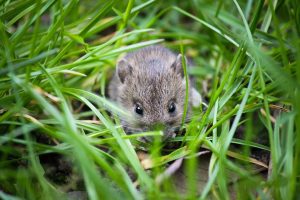The disease is known as Hantavirus-Related Acute Respiratory Disease Syndrome (Hantavirus Pulmonary Syndrome). There has been an impressive accumulation of knowledge about this illness in a short time, however, many unanswered questions still remain.
What we know:
- The risk is specifically to those individuals who come in contact with infected rodents and their droppings.
- The risk of infection is slight but is a REAL risk.
- 38% of people infected with Hantavirus have died.
This guide will provide a brief review of the disease, its symptoms, cause, mode of transmission, treatment and prevention.
RISK
- Hantavirus has been identified as a health risk to the general population in the US, Canada and South America.
- The risk is specifically associated with contact with the deer mouse but this does not rule out other rodents such as: other mice, pack rats, chipmunks or ground squirrels.
- High risk environments will be encountered when disturbing nesting materials, burrows, droppings and surrounding soil, etc.
- The risk is higher in the enclosed environments.
- Approximately 38% of affected people did not survive.
If simple and reasonable precautions are followed the risk of contamination is very slight. The best approach for disease control and prevention is through preventing rodent infestations.
TRANSMISSION
- Hantavirus is transmitted in the urine, saliva and feces of the rodent.
- It is transmitted when the rodent secretions are disturbed and the dust created is inhaled into the lungs of a person.
- The virus has also been shown to be transmitted by rodent bites.
- Direct contact with contaminated rodents will increase the risk of the virus inhalation.
- Once outside the body of the rodent the virus likely does not survive for long periods (hours or days). Further studies are being conducted.
- The virus is inactivated by most disinfectants (dilute solution of bleach or most household disinfectants).
Dust suppression and disinfecting of rodent contaminated material are the major principles of prevention.
SYMPTOMS
Only nonspecific symptoms are present before respiratory distress occurs.
Infected individuals have nonspecific flu-like symptoms such as:
- Fever
- Muscle pain and ache
- Cough
- Headache
- Nausea and vomiting
The presence of the above symptoms is not specific for Hantavirus and can be caused by many ailments.
The only specific symptom of Hantavirus disease is very serious and is characterized by the sudden onset of difficulty in breathing that rapidly worsens. Individuals experiencing pneumonia like symptoms should seek immediate medical attention and inform care givers of rodent exposure.
PREVENTION
There are four major areas in the prevention of infection with the Hantavirus:
- Use
appropriate rodent control.
- Controlling the population of rodents in enclosed spaces will obviously greatly minimize the risk.
- Avoid
infested areas and avoid creating dust.
- Dust suppression (by wetting down infested areas with diluted disinfectant and allowing it to soak for 15 minutes will minimize the airborne contaminates).
- Use
appropriate clean-up procedures.
- Regular/effective cleaning and sealing procedures for outdoor equipment and work sites where this hazard could exist.
- Use
appropriate personal protective equipment around high-risk environments.
- Respiratory Protection such as the High Efficiency HEPA (P100) Filter Respirator meets Occupational Health and Safety standards.
RODENT CONTROL
Since rodents are the main carrier, it is important to, whenever possible, avoid an infestation by using appropriate rodent control.
There are several ways to control or minimize the rodent population in an area and some are listed below.
- Keep area clean.
- Proper placements of commercial traps and rodenticides.
- Use a commercial ultra-sonic device in enclosed areas as appropriate.
- Seal all openings of more than quarter inch diameter.
- Use metal flashings at the base of wooden or earthen structures.
- Eliminate food sources and nesting sites by keeping food and garbage covered and stored in rodent proof container.
- Remove spilled foods and dispose of trash promptly away from the facility.
- Cut grass, bush and dense shrubbery within 100 feet of the facility.
Poulin’s Pest Control can provide a monthly maintenance program to eliminate and protect against mice infestations.

